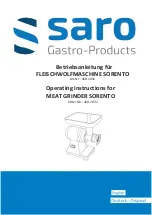
Instruction Manual
Section Five
CHAPTER 4
Shell End Mill and Other End Mills
I.
SET-UP PREPARATIONS
The set-up for the periphery is the same as for a Plain Milling Cutter except that
the cutter is held in a workhead with an adaptor arbor or collet rather than being
held between centers. See Chapter 3, page 36. The K. 0. Lee air-bearing work
head for grinding end mills is described in Chapter 14, page 92,
PHOTO 23 PHOTO 24
II. SETTING THE CLEARANCE ANCLE
A. For non-tilthead grinders,
the cutter is most easily sharpened with the cutting
edge facing up at the point of contact with the wheel (Photo 23), and the
workhead such as B942, placed at the left end of the table. This method is
recommended for right-hand end mills. If the cutter is a left-hand end mill,
then the workhead should be placed toward the right side of the table, work
ing from the right side of the wheel, with the toothrest in both cases being
attached to the bracket over the wheel. (Page 20 shows below center tooth
rest location.)
B.
For tilthead grinders,
the toothrest will generally be held from below the cup
wheel, and the workhead will be placed at the right or left side of the table,
depending on the rotation of the cutter (right or left hand).
III. SHARPENING PROCESS PERIPHERY
A, Repeat the same peripheral grinding sequence as described in Chapter 3, the
cutter being cammed on the rigid toothrest.
B. When using a workhead such as the B942, set a stop on the table to limit the
travel of the workhead toward the wheel. This stop will prevent the cutter
tooth from sliding off the toothrest. When the machine is operated from
the front, the right hand usually moves the table travel while the left hand
holds the workhead hand-nut, indexing or camming the tooth flute against
the toothrest. If the end mill is left hand, or if the toothrest is from below
the wheel, the reverse usage of hands will be necessary. See Photo 24.
IV. GRINDING THE FACE AND CHAMFER
A.
Using
a
Non-Tilthead Grinder:
1. Assuming the cutter has a chamfer (corner angle), locate the center of
the chamfer of a tooth face with a pencil, and put this point on the same
horizontal plane as that of the center of the cutter by means of the height
—38—
















































